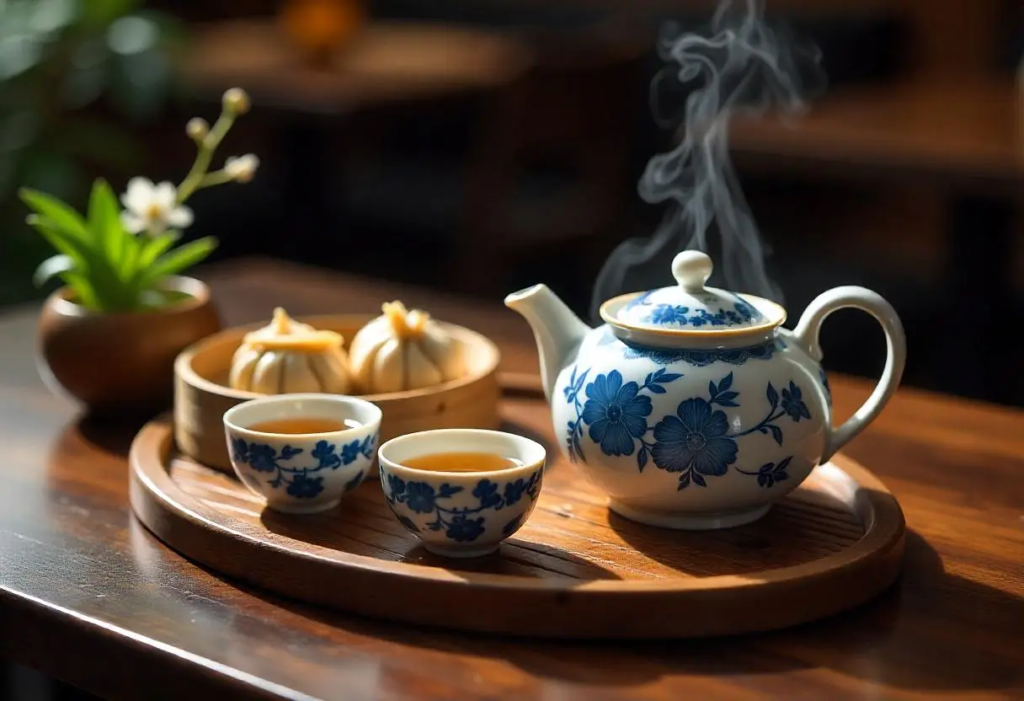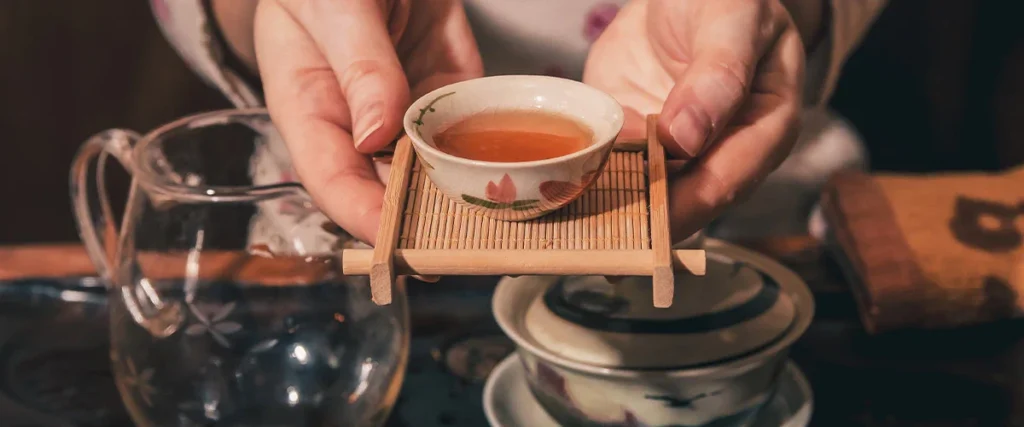When you sit down at a Chinese restaurant in the U.S., you’re often greeted with a warm pot of tea before you even look at the menu. But have you ever wondered what kind of tea that is? It’s soothing, fragrant, and pairs perfectly with Chinese dishes. In this guide, we’ll break down everything about the tea served in Chinese restaurants—why it’s served, what kind it is, and even whether you can get the same one at home.
What Kind of Tea Do Chinese Restaurants Serve?
Most Chinese restaurants in the United States serve jasmine tea, oolong tea, or pu-erh tea—each with its own flavor and cultural importance. But the most common is jasmine tea. This tea is made from green tea leaves infused with the aroma of jasmine blossoms. It’s light, slightly floral, and doesn’t overpower the taste of food, which makes it the perfect companion to your favorite Chinese dishes like lo mein, fried rice, or kung pao chicken.
In some traditional restaurants, especially those with Cantonese roots, you may be served oolong tea, which is slightly stronger and more complex in flavor. Others might serve pu-erh tea, which is aged and has a deep, earthy flavor. But jasmine tea remains the most recognizable and frequently used type.
The type of tea may vary slightly depending on the region of China the restaurant draws its cuisine from, but jasmine is the go-to choice in most places.
Why Do They Serve Tea Before Food?
Serving tea before food is a long-standing tradition in Chinese culture. It’s not just a warm welcome—it also prepares your stomach for food. Tea is known to aid digestion, cleanse the palate, and stimulate appetite. In traditional Chinese medicine, warm tea is believed to balance the body’s energy and help with the digestion of fatty or fried foods, which are common in restaurant dishes.
Culturally, offering tea is a sign of hospitality and respect. In a traditional Chinese household, serving tea is the first step in welcoming guests. That same spirit is carried into restaurants. So when your server brings you tea without asking, they’re actually honoring a deep-rooted custom that dates back thousands of years.
What Is Jasmine Tea? (The Most Common One)
Jasmine tea is the most commonly served tea in Chinese restaurants across the U.S. It’s made by blending green tea leaves with freshly harvested jasmine blossoms, allowing the fragrance to infuse naturally. This method creates a delicate floral taste that’s both refreshing and calming. While it’s often made with green tea as a base, you may also find varieties that use white or black tea leaves.

The flavor is subtle, never bitter, and works well what is the tea used in chinese restaurants a variety of dishes. Jasmine tea has also become one of the most exported Chinese teas because of its popularity in Western countries. Its beautiful aroma and calming qualities make it a perfect introduction to Chinese tea culture.
Is Jasmine Tea Good for You?
Yes, jasmine tea is very good for you. Since it’s usually made from green tea, it contains antioxidants like catechins and polyphenols, which can help protect your body from damage caused by free radicals. It may also support weight loss, improve heart health, and boost your immune system. Some studies even suggest it can help reduce stress and improve mental clarity thanks to its relaxing aroma.
Drinking jasmine tea regularly, especially without added sugar, is a healthy choice for most people. It’s calorie-free, hydrating, and has a calming effect that makes it great for both mind and body.
Can Kids Drink Jasmine Tea?
Generally, kids can drink jasmine tea, but in small amounts. Because jasmine tea contains caffeine (since it’s based on green tea), it’s not something children should consume in large quantities. A small cup occasionally is usually fine, especially if it’s diluted or brewed lightly.
Parents should avoid giving sweetened bottled versions that may contain added sugars or artificial flavors. A simple, home-brewed jasmine tea is a much better option if you’re thinking about letting your child try it.
What Does Jasmine Tea Taste Like?
Jasmine tea has a light, floral flavor with a sweet aroma. The base green tea gives it a gentle grassy note, while the jasmine flowers bring a fragrant, slightly sweet finish. The result is a smooth, refreshing drink that doesn’t overpower the palate, making it ideal to enjoy with food.
It’s not bitter, unless over-brewed, and has a very soothing taste that many people find calming. It’s easy to enjoy even if you’re not usually a tea drinker.
What About Oolong Tea?
Oolong tea is another popular option served in some Chinese restaurants, especially those focusing on dim sum or more traditional menus. Oolong is semi-oxidized, falling somewhere between green and black tea. Its flavor is more complex than jasmine tea—often described as nutty, fruity, or even creamy, depending on how it’s processed.
Oolong tea is praised for its digestive benefits and is often served with heavier meals. In Chinese culture, it’s known to help break down oily foods and support metabolism. Restaurants that offer oolong tea usually cater to customers who appreciate more traditional or authentic Chinese cuisine.
Is Pu-erh Tea Popular in the U.S.?
Pu-erh tea, pronounced “poo-air,” is less commonly served in Chinese restaurants, but it’s gaining popularity—especially in more authentic or high-end establishments. This tea is made from fermented tea leaves and aged over time, sometimes for years. The aging process gives it a deep, earthy flavor that’s unlike any other tea.
In the U.S., pu-erh tea has a niche following among tea enthusiasts and people interested in health benefits. It’s known for helping lower cholesterol, aid digestion, and improve gut health due to the probiotics developed during fermentation.
While it may not be the first choice at most casual Chinese restaurants, it’s definitely a part of the broader Chinese tea tradition that’s worth exploring.
Do All Chinese Restaurants Use the Same Tea?
No, not all Chinese restaurants use the same tea. While jasmine tea is the most common, some places may use oolong, pu-erh, or even dragon well tea (Longjing), depending on the chef’s background or the restaurant’s culinary style. Some budget-friendly places may use tea bags, while more traditional or upscale restaurants may serve loose-leaf teas brewed in pots.

Restaurants aiming for authenticity usually prefer loose-leaf teas, which offer a richer flavor and better quality. The choice of tea can also reflect the regional influence of the cuisine—northern Chinese restaurants may serve different teas than southern or Sichuan-style places.
Loose Leaf vs. Tea Bags – What’s Better?
Loose-leaf tea is generally considered superior to tea bags. It’s fresher, more flavorful, and allows the tea leaves to expand fully during brewing. Most Chinese restaurants that prioritize quality will use loose-leaf teas for their aroma and depth.
Tea bags, on the other hand, are often filled with broken leaves or tea dust, which results in a weaker flavor. Some casual restaurants may use tea bags for convenience, but you’ll likely notice a difference in taste.
If you’ve ever had an amazing cup of tea at a restaurant and want to replicate it at home, look for high-quality loose-leaf jasmine or oolong tea.
Can You Buy the Same Tea at Home?
Yes, you can absolutely buy the same tea served in Chinese restaurants for home use. Many Asian grocery stores and online marketplaces carry high-quality Chinese teas. Look for brands that specialize in jasmine pearls, Tieguanyin oolong, or aged pu-erh cakes.
If you’re just starting out, try a loose-leaf jasmine green tea—it’s easy to brew and has a familiar taste. You’ll also find a variety of options at stores like H-Mart, 99 Ranch, or online platforms like Amazon and Teavivre.
Pro tip: Use a ceramic or glass teapot, and don’t over-steep. Usually, 2–3 minutes is enough for most Chinese teas.
Is the Tea Free at Chinese Restaurants?
In most Chinese restaurants in the U.S., tea is served for free, especially during lunch or dinner service. It’s considered part of the dining experience and is rarely listed as a separate item on the menu.
However, some higher-end restaurants or specialty teahouses may charge for premium teas or offer a selection you can order à la carte. Always check the menu or ask the server if you’re unsure.
Can You Ask for a Different Kind of Tea?
Yes, in many places, you can ask for a different kind of tea. If the restaurant has other options, they’ll be happy to accommodate your request. Some may even have a tea menu, especially in dim sum restaurants or those with a focus on tea culture.
If you prefer something like green tea without jasmine, or if you’re curious about trying pu-erh or white tea, just ask. Most servers will be happy to explain the differences or make a recommendation.
The Bottom Line
The tea served in Chinese restaurants is more than just a drink—it’s a deep cultural tradition with health benefits, historical roots, and a touch of hospitality. Whether it’s jasmine, oolong, or pu-erh, each tea has its own flavor and story.
Now that you know what tea is served, why it’s served, and how to enjoy it at home, you’ll never look at that warm teapot the same way again. So next time you’re at a Chinese restaurant, take a sip, relax, and appreciate the tradition behind the cup.

